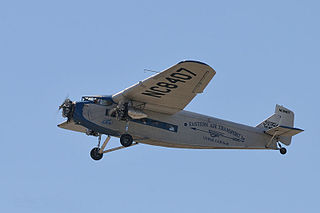
The Ford Trimotor is an American three-engined transport aircraft. Production started in 1925 by the companies of Henry Ford and ended on June 7, 1933, after 199 had been made. It was designed for the civil aviation market, but also saw service with military units.

Beverly Homer DeLay was an American aviator who pioneered many of the popular stunts used in the early barnstorming air-shows. He soon adapted them for the movies, where he appeared with top Hollywood stars. DeLay died in a plane crash that was almost certainly caused by sabotage, but no one was ever charged in connection with the death.

Only Angels Have Wings is a 1939 American adventure romantic drama film directed by Howard Hawks, starring Cary Grant and Jean Arthur, and is based on a story written by Hawks.
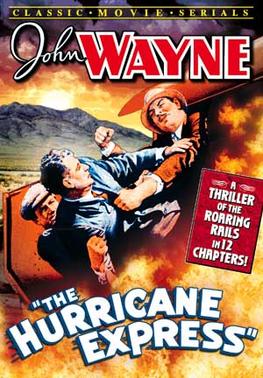
The Hurricane Express is a 1932 American Pre-Code 12-chapter Mascot Pictures film serial. Written by Colbert Clark, Barney Sarecky, Wyndham Gittens, George Morgan, and J.P. McGowan, the serial was directed by Armand Schaeffer and J.P. McGowan and produced by Nat Levine. The Hurricane Express stars John Wayne as aircraft pilot Larry Baker. Wayne goes after a mystery villain named "The Wrecker", who was responsible for a train crash that killed Baker's father.
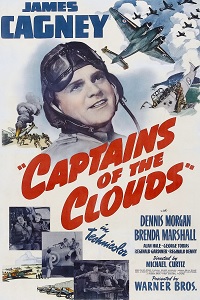
Captains of the Clouds is a 1942 American war film in Technicolor, directed by Michael Curtiz and starring James Cagney. It was produced by William Cagney, with Hal B. Wallis as executive producer. The screenplay was written by Arthur T. Horman, Richard Macaulay, and Norman Reilly Raine, based on a story by Horman and Roland Gillett. The cinematography was by Wilfred M. Cline and Sol Polito and was notable in that it was the first feature-length Hollywood production filmed entirely in Canada.
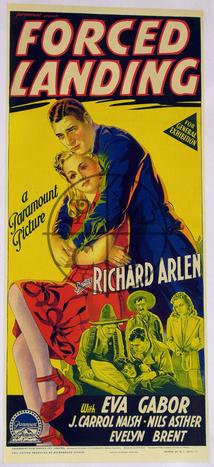
Forced Landing is a 1941 American action film directed by Gordon Wiles and distributed by Paramount Pictures. The film recounts the exploits of a pilot in Mosaque, an imaginary country in the midst of turmoil. Forced Landing stars Richard Arlen, Eva Gabor, J. Carrol Naish, Nils Asther and Evelyn Brent.
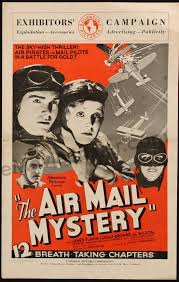
The Airmail Mystery is a 1932 Universal pre-Code movie serial directed by Ray Taylor, written by Ella O'Neill, starring James Flavin and Wheeler Oakman, and featuring Al Wilson doing the aerial stunts. The Airmail Mystery was Universal's first aviation serial that set the pattern for the aviation serials and feature films to follow. The film also marks the film debut of James Flavin. The Airmail Mystery is considered a lost film.

The Phantom of the Air is a 12-episode 1933 Pre-Code Universal film serial directed by Ray Taylor. The film stars Tom Tyler, who was cast most often in Westerns. Other actors include Gloria Shea, LeRoy Mason, Craig Reynolds and William Desmond.
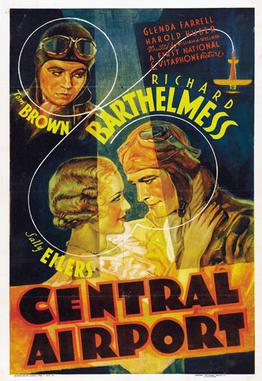
Central Airport is a 1933 American pre-Code aviation drama film directed by William A. Wellman, based on the John C. "Jack" Moffitt story, "Hawk's Mate". The film stars Richard Barthelmess and Sally Eilers. Central Airport was produced and released by Warner Bros., on April 15, 1933. John Wayne had an uncredited part in the film, playing a co-pilot, and this film features his first on-screen death.
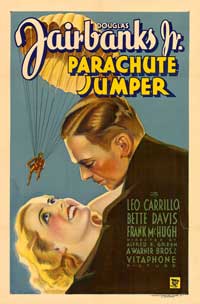
Parachute Jumper is a 1933 American pre-Code black-and-white comedy drama film directed by Alfred E. Green. Based on a story by Rian James titled "Some Call It Love", it stars Douglas Fairbanks Jr., Bette Davis and Frank McHugh.

The Eagle and the Hawk is a 1933 American Pre-Code aerial war film set in World War I. It was directed by Stuart Walker and Mitchell Leisen and was based on an original story by John Monk Saunders. The film stars Fredric March and Cary Grant as Royal Flying Corps fighter pilots. The supporting cast includes Carole Lombard, Jack Oakie, and Sir Guy Standing.
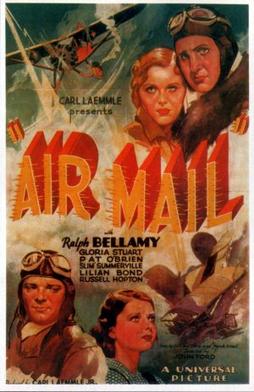
Air Mail is a 1932 American pre-Code adventure film directed by John Ford, based on a story by Dale Van Every and Frank "Spig" Wead. The film stars Ralph Bellamy, Pat O'Brien and Gloria Stuart. A copy is preserved in the Library of Congress.

Stout Metal Airplane Division of the Ford Motor Company was an American aircraft manufacturer founded by William Bushnell Stout as the Stout Metal Airplane Co. in 1922. The company was purchased by Ford Motor Company in 1924 and later produced the Ford Trimotor. At the height of the Great Depression, Ford closed the aircraft design and production division in 1936, temporarily re-entering the aviation market with the production of the B-24, at the Willow Run aircraft factory during World War II.

Albert Peter Wilson was an American film actor, producer and stunt pilot. Wilson died in Cleveland, Ohio, in an air crash while doing flying stunts at the 1932 Cleveland Air Races show.
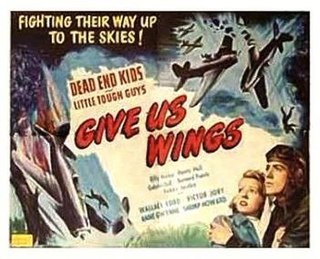
Give Us Wings is a 1940 Universal comedic film starring the Dead End Kids and the Little Tough Guys. Several members of the casts of those series were also featured in "The East Side Kids" films.
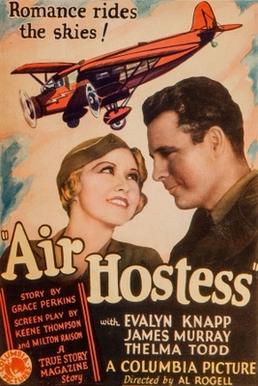
Air Hostess is a 1933 American Pre-Code aviation-themed melodrama based on a serial published in a 1919 True Story Magazine article called Air Hostess by Grace Perkins, also known as Dora Macy. Director Albert Rogell who had moved from shorts to B-films, had been interested in aviation having already helmed a similar feature, The Flying Marine (1929). In Air Hostess, the studio had attempted to merge flying and romance. Advertising stressed, "A date in the skies ... a rendezvous in the heavens...where love zooms with thrill after thrill ... but finds a happy landing!"
The Sky Hawk is a 1929 American pre-Code adventure film, produced and distributed by Fox Film Corporation and directed by John G. Blystone. The screenplay was adapted by Llewellyn Hughes from his article "Chap Called Bardell" and novelized by Guy Fowler. The film stars John Garrick, Helen Chandler and Gilbert Emery.

The Man Who Found Himself, also known as Wings of Mercy, is a 1937 American aviation film based on the unpublished story "Wings of Mercy" by Alice B. Curtis. The film marked the first starring role for 19-year-old Joan Fontaine, who was billed as the "new RKO screen personality", highlighted following the end of the film by a special "on screen" introduction. Unlike many of the period films that appeared to glorify aviation, it is a complex film, examining the motivations of both doctors and pilots.

Daredevils of the Clouds is a 1948 American drama film directed by George Blair and produced by Republic Pictures. The film stars Robert Livingston, Mae Clarke and James Cardwell. Daredevils of the Clouds depicts bush pilot flying in northern Canada.

Fugitive in the Sky is a 1936 American aviation drama film directed by Nick Grinde and written by George Bricker. The stars are Jean Muir, Warren Hull, Gordon Oliver, Carlyle Moore Jr., Howard Phillips, Winifred Shaw and Mary Treen. Fugitive in the Sky was released by Warner Bros. on November 28, 1936, a mere six months after the Paramount Pictures feature, 13 Hours by Air, considered by aviation film historian Michael Paris in From the Wright Brothers to Top Gun: Aviation, Nationalism, and Popular Cinema (1995), as a virtual "remake" of the earlier film.




















